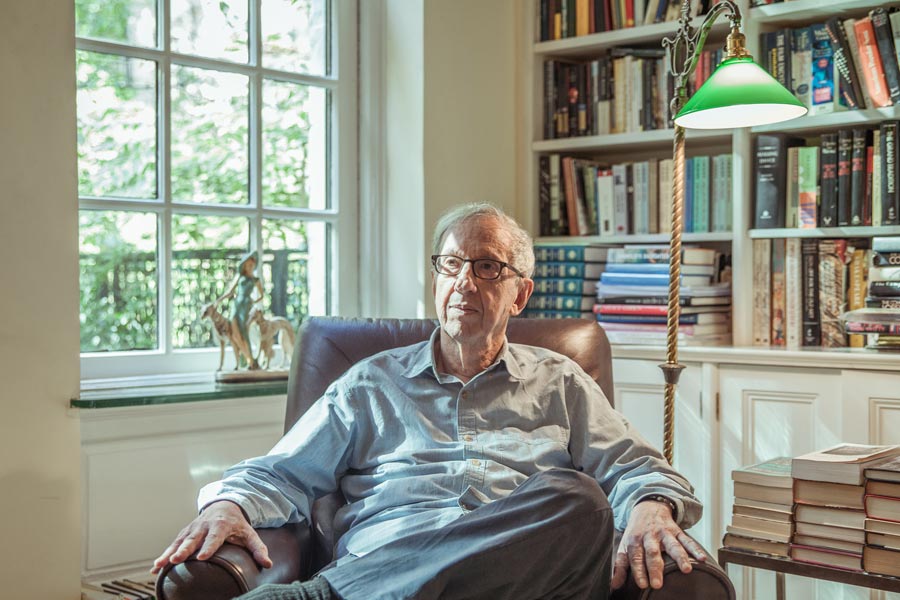Robert Gottlieb, an illustrious editor at Simon & Schuster, Alfred A. Knopf and The New Yorker whose deft touch shaped a bibliophile’s library of novels, nonfiction books and magazine articles by a pantheon of acclaimed writers from the middle to the late 20th century, died Wednesday in Manhattan. He was 92.
The death, at a hospital, was confirmed by his wife, Maria Tucci.
Gottlieb edited novels by, among many others, John le Carré, Toni Morrison, John Cheever, Joseph Heller, Doris Lessing and Chaim Potok; science fiction by Michael Crichton and Ray Bradbury; histories by Antonia Fraser and Barbara Tuchman; memoirs by former President Bill Clinton and Katharine Graham, the former publisher of The Washington Post; and works by Jessica Mitford and Anthony Burgess.
For three decades at publishing houses Simon & Schuster and Knopf, he turned hundreds of manuscripts into well-received books, many of which sold millions of copies, won awards and made authors wealthy and famous. Colleagues called him incisive but sensitive to writers’ eggshell egos. His skills won him a loyal following of authors, and he became Knopf’s president as well as editor-in-chief.
Then, in 1987, in an abrupt career change from the relative anonymity and serenity of book publishing, Gottlieb was named the third editor in the 62-year history of The New Yorker, one of American journalism’s highest-profile jobs. He replaced William Shawn, the magazine’s legendary editor for 35 years, who had succeeded the founding editor, Harold Ross.
The appointment by S.I. Newhouse Jr., whose family owned both Knopf’s parent company, Random House, and The New Yorker, hit the staff like a bomb. A petition by 154 writers, editors and others protested the forced retirement of Shawn, who had made journalism history with breakthrough articles that became bestselling books: John Hersey’s “Hiroshima,” on the first atomic bombing of a city; Hannah Arendt’s “Eichmann in Jerusalem”; Rachel Carson’s “Silent Spring.”
The petition noted Gottlieb’s reputation for brilliance but nonetheless urged him to withdraw, saying that an insider like Charles McGrath, the magazine’s fiction editor and heir apparent, could best serve its traditions. (McGrath later became editor of The New York Times Book Review and a writer at large for the Times.) But Gottlieb refused to step aside and plunged into the topsy-turvy world of weekly deadlines and strange editor-writer relationships that reversed his long experience in book publishing.
“In a publishing house, you are in a strictly service job as an editor,” he recalled in “The Art of Making Magazines,” a 2012 anthology. “Your job is to serve the book and the writer.” It was different at The New Yorker, he said: “You are the living god. You are not there to please the writers, but the writers are there to satisfy you because they want to be in the magazine.”
Unlike his revered and formal predecessor, who wore jackets and ties, saw people by appointment and was addressed as “Mr. Shawn,” Gottlieb was a quirky collector of kitsch, like plastic women’s handbags, a passionate lover of classical ballet and an eccentric Anglophile who called writers “dear boy.”
He did not attend gossipy magazine lunches, preferring a hot dog in Central Park or a sandwich at his desk. With his long face, heavy glasses and thinning hair, he padded around the office like a beachcomber in old sneakers, baggy pants and rumpled polo shirts, schmoozing with the staff.
Easing the apprehensions of many New Yorker aficionados, he made few and mostly minor changes over five years. He published new contributors, including journalist Raymond Bonner, essayist Judith Thurman and poet Diane Ackerman, and fiction by Robert Stone and Richard Ford. New critics were hired, and Talk of the Town commentaries were opened to more writers and were no longer written anonymously. But he did not shorten the long articles that critics sometimes called long-winded and boring, and he gradually won the trust and affection of most of the staff.
In 1992, Tina Brown, the British editor of Vanity Fair, replaced Gottlieb in an amicable transition and introduced splashy changes. Admirers called them lively topicality and refreshing impertinence. Traditionalists called them vulgar, particularly a portrait of Eustace Tilley, the magazine’s trademark dandy, who appeared on an anniversary cover as an acne-plagued teenager with a gold earring, squinting at a handbill for a Times Square sex shop.
After his New Yorker days, Gottlieb in time resumed editing for Knopf; became a dance critic for The New York Observer; compiled anthologies on dance, jazz and lyrics; and wrote several books, including a 2016 memoir, “Avid Reader: A Life,” in which he addressed the pros and cons of the literary life.
“There are editors who will always feel guilty that they aren’t writers,” he explained. “I can write perfectly well — anybody who’s educated can write perfectly well. It’s very, very hard, and I just don’t like the activity. Whereas reading is like breathing.”
His memoir offered a highlight reel of snarky critiques of authors — Nobel laureate V.S. Naipaul (“a snob”), Tuchman (“her sense of entitlement was sometimes hard to deal with”), William Gaddis (“unrelentingly disgruntled”), Roald Dahl (“erratic and churlish”).
“He wasn’t just an editor, he was the editor,” le Carré told the Times. “I never had an editor to touch him, in any country — nobody who could compare with him.” He noted that Gottlieb, using No. 2 pencils to mark up manuscripts, often signaled changes with hieroglyphics in the margins: a wavy line for language too florid, ellipses or question marks advising a writer to “think harder and try again.”
Robert Adams Gottlieb was born in Manhattan on April 29, 1931, the only child of Charles and Martha (Keen) Gottlieb. His father was a lawyer, his mother a teacher. He grew up on the Upper West Side and attended the Ethical Culture School.
A sickly, lonely, unhappy child, he sought refuge in books, which he sped through. As a teenager, he said, he read Leo Tolstoy’s “War and Peace” in a day and Marcel Proust’s monumental “Remembrance of Things Past” in a week.
“I would read three to four books a day after school, and could read for 16 hours at a time,” he told the Times in 1980. “Mind you, that’s all I did. I belonged to three lending libraries and the public library.”
At Columbia University, he breezed through literature studies and earned a bachelor’s degree, with a Phi Beta Kappa key, in 1952. He received a postgraduate degree from the University of Cambridge in England in 1954.
In 1952, Gottlieb married Muriel Higgins. They had a son, Roger, before divorcing. He married Tucci, an actress, in 1969. They had two children, Lizzie and Nicky.
In addition to Tucci, he is survived by his children and twin grandsons.
The New York Times News Service











